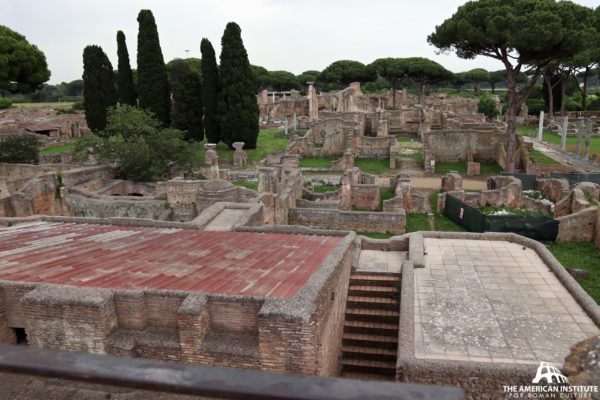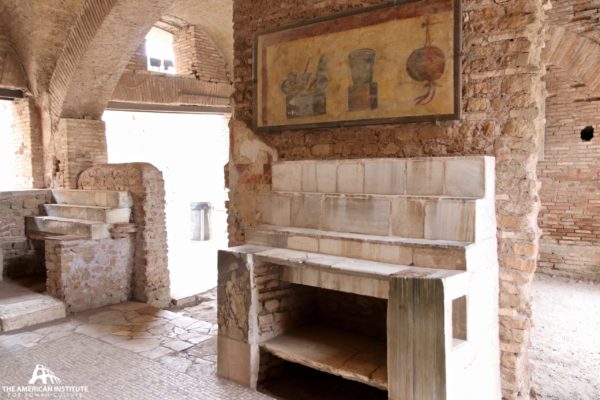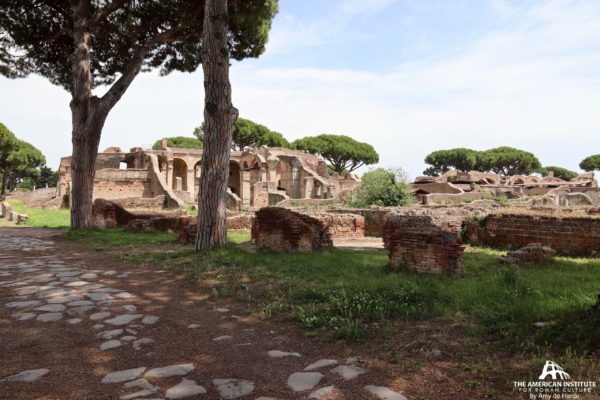Watch our video overview:
Ancient Roman Baths were a place not only for bathing but also for social gatherings, entertainment, and political affairs. The Baths were a democratic place for people of all rankings: men, women, and even slaves frequented these facilities. There were 15 public baths in Ostia Antica, and the remnants we see today tell the story of these buildings that played such an important role in the life of Ancient Romans.
The infrastructure of the baths was very sophisticated. The rooms of hot water pools were heated from below. They were constructed on elevated floors that housed a furnace room directly below. The furnace was managed by the slaves, who kept the fires running constantly. The heat and steam would travel up through hollow bricks, called tuboli, attached to the walls and heat the bathing room on the floor above. The slaves were essential to keep the baths functioning. They worked not only in the furnace rooms, but also in the pool rooms above, carrying towels, attending to the higher-ranked visitors, and maintaining the overall organization and cleanliness of the place. There were bathing rooms designated for the slaves as well, so they didn’t mix with the other visitors.
All the Ancient Roman Baths had a similar structure, a specific architectural plan that was used to keep the Baths functioning and organized. This plan included certain components: the apodyterium or changing room, where the guests would undress and store their clothes; the frigidarium, rooms of cold water pools that were not heated; the tepidarium, a room of lukewarm temperature that served to acclimate guests before entering the next room; the caldarium, the rooms of hot water that were heated by the furnace room, another essential area.
Some scholars, like Dirk Steuernagel, have written about the religious practices within the Roman baths. The Terme del Mitra in Ostia Antica was a private bath house, built around 117-138 AD. Within the bath complex, there was also a Mithraeum; a shrine dedicated to Persian god Mithras, who was venerated by many in Ancient Rome. There was a statue of Mithras and the bull (part of the myth of Mithras) in the center of the room, and the statue now is preserved in the Ostiense archeological museum. After the decline of Ostia, the Terme del Mitra was transformed into a Christian cult space.
References
- COARELLI, FILIPPO, JAMES J. CLAUSS, DANIEL P. HARMON, J ANTHONY CLAUSS, and PIERRE A. MACKAY. Rome and Environs: An Archaeological Guide. 1st ed. University of California Press, 2014. – http://www.jstor.org/stable/10.1525/j.ctt5vk043
- Lätzer-Lasar, Asuman, and Emiliano Rubens Urciuoli. “Lätzer-Lasar/Urciuoli, Urban Religion in Late Antiquity.” p 225-259. Urban Religion in Late Antiquity, 2020. – https://books.google.it/books?id=8PcdEAAAQBAJ&lpg=PA225&ots=XQXwoVhUXG&dq=roman%20baths%20ostia%20antica&lr&hl=pt-BR&pg=PA258#v=onepage&q=terme%20del%20mitra&f=false
- Terme Del Mitra – https://www.ostiaantica.beniculturali.it/it/pannelli-didattici/i-quartieri-residenziali-della-classe-medio-alta/terme-del-mitra/
Explore further:
This content is brought to you by The American Institute for Roman Culture, a 501(C)3 US Non-Profit Organization.
Please support our mission to aid learning and understanding of ancient Rome through free-to-access content by donating today.
Cite This Page
Cite this page as: Darius Arya, The American Institute for Roman Culture, “Ostia, Italy (Ostia Antica) – Chapter 6: Baths and Bathing” Ancient Rome Live. Last modified 08/28/2020. https://ancientromelive.org/ostia-italy-ostia-antica-chapter-6-baths-and-bathing/
License
Created by The American Institute of Roman Culture, published on 08/28/2020 under the following license: Creative Commons: Attribution-NonCommercial-ShareAlike. This license lets others remix, tweak, and build upon this content non-commercially, as long as they credit the author and license their new creations under the identical terms. Please note that content linked from this page may have different licensing terms.







